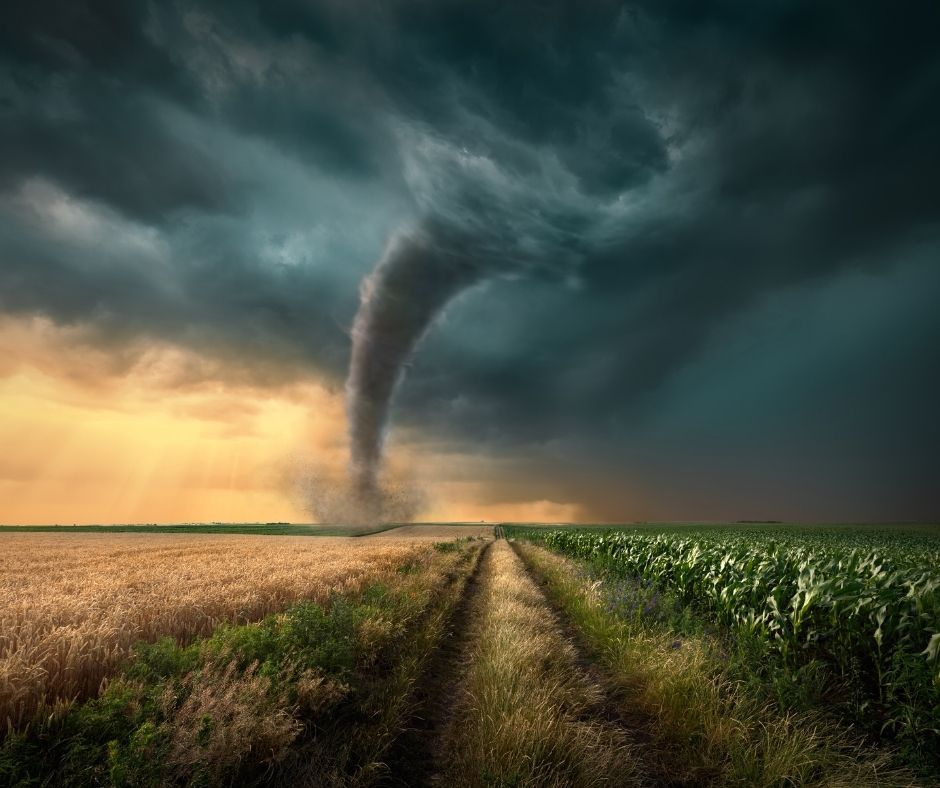
Tornadoes are violently rotating columns of air that extend from a thunderstorm to the ground. Tornadoes are violent: they can completely destroy well-made structures, uproot trees and hurl objects through the air like deadly missiles. Tornadoes can destroy buildings, flip cars, and create deadly flying debris. A tornado can:
- Happen anytime and anywhere.
- Bring intense winds, over 200 miles per hour.
- Look like funnels.
Although severe tornadoes are most common in the Plains States, they can happen anywhere. Learn what to do to keep your loved ones safe. Here are some tips in preparing for a tornado before it happens:
- Know your area’s tornado risk. In the U.S., the Midwest and the Southeast have a greater risk for tornadoes.
- – Know the signs of a tornado, including a rotating, funnel-shaped cloud, an approaching cloud of debris, or a loud roar like a freight train.
- Sign up for your community’s warning system. The Emergency Alert System (EAS) and NOAA Weather Radio also provide emergency alerts. If your community has sirens, then become familiar with the warning tone.
- Pay attention to weather reports. Meteorologists can predict when conditions might be right for a tornado.
- Identify and practice going to a safe shelter such as a safe room built using FEMA criteria or a storm shelter built to ICC 500 standards. The next best protection is a small, interior, windowless room or basement on the lowest level of a sturdy building.
- Plan for your pet. They are an important member of your family, so they need to be included in your family’s emergency plan.
- Prepare for long-term stay at home or sheltering in place by gathering emergency supplies, cleaning supplies, non-perishable foods, water, medical supplies and medication.
If you are under a tornado or severe weather warning:
- Go to NOAA Weather Radio and your local news or official social media accounts for updated emergency information. Follow the instructions of state, local and tribal officials.
- Go to a safe shelter immediately, such as a safe room, basement, storm cellar or a small interior room on the lowest level of a sturdy building.
- Stay away from windows, doors, and outside walls.
- Do not go under an overpass or bridge. You’re safer in a low, flat location.
- Watch out for flying debris that can cause injury or death.
- Use your arms to protect your head and neck.
- If you can’t stay at home, make plans to go to a public shelter.
Staying Safe During a Tornado
- Immediately go to a safe location that you have identified.
- Pay attention to EAS, NOAA Weather Radio, or local alerting systems for current emergency information and instructions.
- Protect yourself by covering your head or neck with your arms and putting materials such as furniture and blankets around or on top of you.
- Do not try to outrun a tornado in a vehicle if you are in a car. If you are in a car or outdoors and cannot get to a building, cover your head and neck with your arms and cover your body with a coat or blanket, if possible.
Staying Safe After a Tornado
- Pay attention to EAS, NOAA Weather Radio, and local authorities for updated information.
- Stay clear of fallen power lines or broken utility lines.
- Contact your healthcare provider if you are sick and need medical attention. Wait for further care instructions and continue to shelter in place.
- Wear appropriate gear during clean-up such as thick-soled shoes, long pants, and work gloves, use appropriate face coverings or masks if cleaning mold or other debris.
Not having enough coverage can be just as traumatic as experiencing damage to your home and personal belongings. Take a few minutes to review your policy to make sure you have enough coverage. Speak with one of our agents about tornado coverage and any other questions you might have.
Review your personal property coverage. Over time, we buy, sell, and replace items in our homes. You’ll want to have enough coverage to repair or replace your personal property in case of damage to your home and belongings. Optional replacement cost coverage for your personal property allows you to replace or repair items that were damaged or destroyed based on current market prices.
Review replacement cost. Make sure your home has the right coverage to replace/repair your home. Will the amount on your policy cover the cost to completely rebuild your home? Please keep in mind that this is not the same amount as the value of your home in the real estate market. It is the actual cost, including labor and materials, to rebuild.
Contact Bassler & Co. Insurance Agency in Northbrook, Illinois to protect your home and add this coverage. We can provide coverage from many insurance carriers so you receive the insurance for your budget and needs! You can reach us by phone at (847) 480-0800 or visit our website at http://www.basslerins.com/. Source: https://www.ready.gov/tornadoes#:~:text=Go%20to%20a%20safe%20shelter,in%20a%20low%2C%20flat%20location and https://www.redcross.org/get-help/how-to-prepare-for-emergencies/types-of-emergencies/tornado.html
